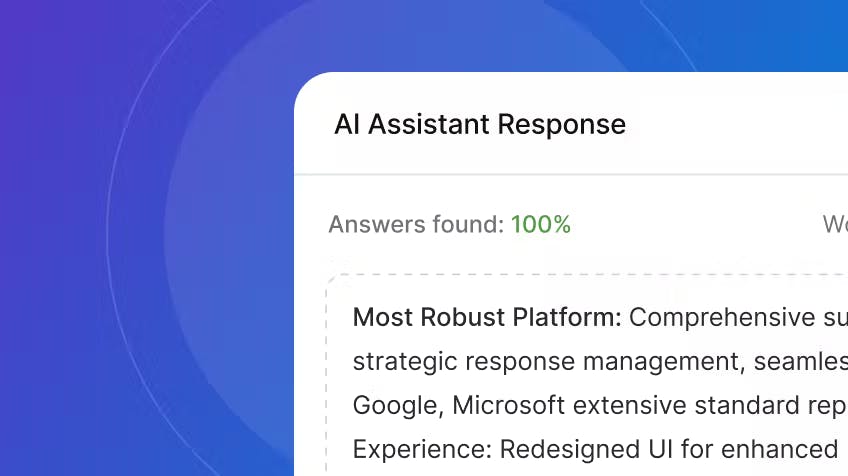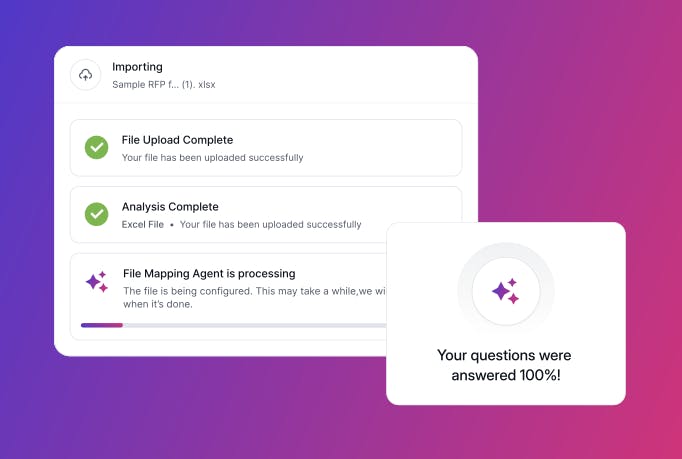Bid and proposal professionals operate in a high-stakes environment where speed, accuracy, and strategic execution determine success. Buyer expectations are growing and competition is intensifying, which has placed an even greater emphasis on the ability to deliver high-quality, data-driven responses. However, many bid teams are simultaneously facing increasing workloads, tighter deadlines, and more complex information requests.
According to Responsive’s 2024 State of Strategic Response Management (SRM) Report:
- 77% of bid and proposal professionals have seen their workload increase in the last year
- More than 70% of companies report annual revenue growth tied to RFPs, bids, tenders, and proposals.
The pressure is mounting. Buyers today expect more than just a well-written proposal— they demand precise, tailored responses that reflect deep industry knowledge and a clear understanding of their unique needs.
Yet, despite this rising demand, many response teams remain under-resourced, making it difficult to scale operations efficiently. This is where artificial intelligence (AI) is making the biggest impact.
As mentioned in the recently published Responsive AI Handbook, AI-powered SRM solutions are not just automating tasks but reshaping how teams approach proposal writing, collaboration, and decision-making.
But what does AI really mean for bid and proposal professionals? How does it shift the dynamics of response management? And most importantly, how can teams harness its power effectively? This primer will explore these questions and examine AI’s transformative role in the bid and proposal industry.
The growing challenges in bid and proposal management
AI has already permanently changed procurement. Buyers are no longer making decisions in isolation — they are leveraging vast teams of stakeholders, requiring comprehensive and highly specific responses that can only be met with AI assistance.
Today’s buyers demand faster response times, platform-based solutions, and increased transparency around compliance, security, and ESG (Environmental, Social, and Governance) factors. More stakeholders are involved in the decision-making process, leading to more rigorous evaluations and heightened scrutiny of proposals.
Bid teams are feeling the weight of this shift. The traditional ways of managing RFPs and security questionnaires — relying on manual searches, spreadsheets, and disconnected systems — are now obsolete.
The increasing workload for response teams
The complexity and volume of RFPs, DDQs, security questionnaires, and other information requests have surged. As Rick Harris, CEO of APMP, explains:
"Most organizations aren’t equipped to handle the increased volume and complexity because they struggle with knowledge management and siloed org charts that isolate bid and proposal teams, which are driving one of the most strategic, revenue-generating functions in an enterprise.”
Rick Harris
CEO of APMP
Without the right tools, bid and proposal teams risk missing deadlines, losing deals, and failing to deliver the level of personalization required to stand out in an ever-growing crowded market.
Understanding AI’s role in Strategic Response Management

AI is a catch-all term that refers to a broad set of technologies that enable machines to perform tasks that typically require human intelligence. These include:
- Machine Learning (ML)
- Deep Learning
- Generative AI (GenAI)
- Large Language Models (LLMs) and Small Language Models (SLMs)
- Natural Language Processing (NLP)
Each of these types of AI have all become fundamental to modern response management systems. Before we explore AI’s role in SRM, let’s first review each of these types of AI in further detail.
Machine Learning (ML)
Machine learning (ML) surpasses Traditional AI by training on data to recognize patterns and make decisions without explicit programming. It powers AI applications by enabling continuous improvement based on feedback and new information.
- Data-driven content recommendations: ML analyzes historical data and user behavior to suggest the most relevant content. It learns from past RFPs, responses, and win rates to surface high-performing content, improving success rates over time.
- Better writing: ML refines proposals by identifying the most effective language, tone, and format. If a particular style leads to higher win rates, the system recommends similar approaches for future responses.
- Strategic decision-making: ML enhances predictive analytics using advanced models like regression analysis and decision trees to forecast bid success. It factors in competitor analysis, client sentiment, and industry trends for more accurate predictions.
- Dynamic workflow optimization: Unlike rule-based AI, ML adapts workflows in real time, prioritizing tasks based on evolving data. It identifies top-performing team members and optimizes task assignments accordingly.
Deep Learning
Deep Learning, a more advanced subset of ML, leverages multi-layered neural networks to recognize complex patterns in large volumes of unstructured data, such as text, images, and speech.
- Automated summaries: Deep Learning models extract key points from lengthy documents, like government-issued RFPs, generating concise summaries and saving valuable time.
- Compliance matrices: These models analyze images, charts, and diagrams to flag potential compliance risks or content requiring further review.
- Real-time language translation: Deep Learning enables accurate translation of content while maintaining context and meaning, helping organizations pursue global opportunities.
Generative AI
Generative AI (GenAI) creates new content from existing data, unlike Traditional AI, Machine Learning, or Deep Learning, which analyze patterns without generating original material.
- Conversational AI for real-time assistance: GenAI powers virtual assistants that help response teams by answering questions, suggesting content, and tailoring responses in real time.
- Creative brainstorming: GenAI overcomes writer’s block by proposing fresh angles, narratives, and approaches to enhance content creation.
Large Language Models (LLMs) and Small Language Models (SLMs)
LLMs and SLMs are advanced forms of GenAI trained on vast datasets to understand and generate human-like language. LLMs are broad and general, while SLMs are domain-specific, optimizing content for particular use cases like security questionnaires. They enhance GenAI’s contextual understanding and customization in SRM.
- Contextualized content recommendations: LLMs and SLMs analyze each question’s context to suggest the most relevant content, ensuring responses are precise, personalized, and aligned with the requester’s needs.
- Enhanced proposal drafting and editing: These models generate full-length drafts in minutes and highlight areas requiring SME input, balancing automation with human expertise for refined, high-quality proposals.
Natural Language Processing (NLP)
NLP enables computers to understand, interpret, and respond to human language, making it a core technology in SRM platforms. It enhances communication and information exchange across AI models.
- Automated question-answer matching: NLP, combined with ML, powers semantic search to analyze question language, understand intent, and match it with the most relevant response, reducing manual search effort.
- Data extraction: NLP quickly identifies key details like names, dates, and compliance terms from lengthy documents, streamlining decision-making, compliance checks, and legal reviews.
For further reading on AI tools outside the scope of this primer, check out the following selection of past Responsive blogs:
How AI powers Strategic Response Management

Strategic Response Management (SRM) refers to the people, practices, and technology that unlock organizational knowledge for profitable growth. In short, SRM brings together experts from across an organization to centralize and democratize organizational knowledge to drive more revenue while reducing business risk.
Traditional operating models lean on siloed teams and scattered information. SRM breaks down these walls and streamlines collaboration and information sharing across all revenue-generating teams. AI-driven SRM platforms (like Responsive) take this idea even further with extensive automation and by enhancing various aspects of the bid and proposal process. This includes:
- Centralizing knowledge management: AI allows access to up-to-date, trusted content for accurate and consistent responses.
- Accelerating first drafts: AI can generate up to 80% of a proposal’s first draft instantly, reducing manual effort.
- Automating workflow coordination: AI-powered workflows assign questions to the right subject matter experts (SMEs) and track project timelines seamlessly.
- Improving compliance and risk management: AI flags potential compliance issues and ensures adherence to branding and regulatory standards.
AI-led SRM drives unparalleled efficiency, collaboration, decision-making, and guided experiences at scale — empowering organizations to command an outsized competitive advantage while also enabling bid and proposal teams to maximize their impact.
How AI is transforming bid and proposal teams
Accelerates response times
AI enables bid teams to deliver better responses faster by recommending, generating, and refining responses based on past successful proposals. AI also automatically tailors executive summaries and cover letters to match each opportunity.
As Stephen Diorio, Managing Director at The Revenue Enablement Institute and Senior Fellow, AI at Wharton, explains:
"With the right SRM approach, organizations can effectively and strategically leverage their knowledge across all customer-facing teams to present compelling, compliant narratives that win business. Armed with AI, advanced analytics, and mature approaches to knowledge management and cross-functional collaboration, companies at the forefront of SRM adoption will continue to see outsized impact on revenue operations and gain key competitive advantages.”
Stephen Diorio
Managing Director at The Revenue Enablement Institute and Senior Fellow, AI at Wharton
Enhances workflow automation
AI streamlines project management and team collaboration, creating a smooth, efficient process from intake to submission. AI-powered automation:
- Matches response tasks to the right experts based on expertise and workload.
- Schedules review cycles to ensure compliance and completeness.
- Tracks response progress in real-time to avoid bottlenecks.
Improves decision-making and win rates
AI doesn’t just make the process faster — it makes it smarter. By analyzing past proposal data stored in your accurate, current, and relevant Content Library, AI can:
- Predict bid success rates based on historical performance and competitor insights.
- Identify high-value opportunities that align with business goals.
Humans at the helm; AI at the ready

While AI is revolutionizing bid and proposal management, AI is not replacing the professionals who drive these processes — it's empowering them. AI acts as an assistant, automating repetitive tasks and enabling teams to focus on high-value activities that require human intelligence, creativity, and relationship-building.
The balance between AI and human expertise
- AI handles routine tasks: Automating first drafts, retrieving relevant content, and augmenting compliance allows professionals to dedicate more time to strategic and personalized responses.
- Humans provide critical thinking and storytelling: AI can generate responses, but bid teams add the emotional intelligence and persuasive storytelling needed to craft compelling proposals.
- Collaboration between AI and professionals enhances efficiency: Organizations using AI-driven proposal tools see significant improvements in response time and win rates without sacrificing quality.
The role of human judgment and expertise
Melinda Bunston, CEO of APMP UK, reinforces this point based on her experience as a Senior Capture Manager at QinetiQ:
“One thing AI can’t do — and I don’t think we’ll ever get it — is having emotional intelligence. When you read something that’s quite lengthy, that’s been written solely by AI, it can come across as soulless. It will be compliant. It will answer the question. But AI just doesn’t have that passion that a human can bring to something. And it doesn’t have the capacity to really understand the customer on a human level and personalize responses beyond just curating relevant information.”
Melinda Bunston
CEO of APMP UK
Melinda’s comment highlights that while AI enhances efficiency, human expertise remains essential for writing proposals tailored to each client’s unique needs and concerns. Humans are also still essential for building trust and relationships that technology alone cannot achieve, as well as ensuring the strategic alignment of proposals with broader business goals.
AI as a force multiplier, not a replacement
According to the Responsive AI Handbook, 68% of bid and proposal professionals believe AI will significantly improve efficiency in their processes, while 52% expect AI to help reduce response times by at least 50%.
Together, AI-powered automation and human insight will lead to:
- Higher-quality proposals delivered faster.
- Improved resource allocation and workload distribution.
- Greater success in securing new business.
AI is not a tool to replace bid and proposal professionals. Instead, AI is a tool that will ensure these professionals will continue to succeed. By embracing AI strategically, organizations can enhance their efficiency and keep humans at the center of decision-making and storytelling.
Key takeaways in understanding AI
AI continues to rapidly change the way bid and proposal professionals work, not by replacing them, but by empowering them. Teams that have embraced AI-driven SRM solutions have already seen:
- Faster, higher-quality responses.
- More efficient workflows.
- Greater strategic alignment and improved win rates.
Organizations that leverage AI aren’t just keeping pace with change — they’re defining the future of Strategic Response Management. The companies that integrate AI into their response strategy today will gain a competitive edge in an increasingly complex and demanding landscape. The time to adopt AI is now.
Ready to explore how AI can transform your bid and proposal process? Learn more about Responsive’s AI-powered SRM platform and see how it can help your team win more deals.
